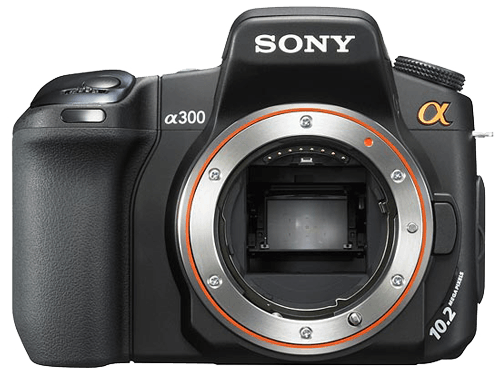Sony Alpha 300 Specs and Scores

The Sony Alpha 300 receives a score of 44 out of 100. Launched in 2008 with an initial price of $690, this DSLR camera measures 131 x 99 x 75mm and weighs 632g (1.39lbs). Though the specifications may seem outdated in today’s fast-paced market, the Sony Alpha 300 still has a place for those seeking a budget-friendly option. The camera’s size and weight make it a comfortable choice for casual photography enthusiasts.
Sony Alpha 300 Overview and Optics
The Sony Alpha 300 receives a score of 49/100 for optics. This camera features a 10.2-megapixel APS-C CCD sensor, which is paired with a Bionz processor. The shooting speed of 3 frames per second is relatively slow compared to modern cameras. The sensor has a DXOMARK score of 64, indicating it might not perform as well as newer models.
The Alpha 300 uses a Sony Alpha DT lens mount and offers built-in image stabilization. With a 3:2 aspect ratio, this camera can produce decent quality images. However, its specifications do not match up to the current market expectations, where higher megapixels, faster shooting speeds, and better sensor quality have become the norm.
The Sony Alpha 300 has some useful features, but it falls behind in today’s market. Its lower score reflects this, as more advanced cameras with improved optics are now available.
Sony Alpha 300 Video Performance
The Sony Alpha 300 does not have video functionality. This camera focuses on photography only.
Sony Alpha 300 Features and Benefits
The feature score of the Sony Alpha 300 is 34/100, which is relatively low in comparison to other cameras on the market. Its screen size measures 2.7 inches, and the screen resolution stands at 230,000 dots. The absence of a touchscreen may limit user experience, especially in terms of convenience and ease of use.
Though the Sony Alpha 300 does not offer a touchscreen, it does come with a flip screen, providing some flexibility when taking photos from various angles. On the other hand, the camera lacks GPS, WIFI, and Bluetooth connectivity, making it less versatile and user-friendly than other models in today’s market.
Taking all these specifications into account, the Sony Alpha 300 falls short compared to other cameras with more advanced features and functionalities. Its low feature score and limited connectivity options make it less appealing for those seeking a modern and convenient photography experience.
Sony Alpha 300 Storage and Battery
The storage and battery of the Sony Alpha 300 receive a score of 32/100. This camera has one memory card slot, accepting Compact Flash cards. In today’s market, this storage option is less common and may not be as convenient as the widely used SD cards.
The battery life of the Alpha 300 is 730 shots per charge, powered by an NP-FM500H battery. This battery life is relatively decent compared to other cameras in the market, but the lack of USB charging capability limits its flexibility during extended shooting sessions or travel.
Taking these specifications into account, the Sony Alpha 300’s storage and battery performance are subpar compared to the current market standards. The camera’s outdated storage options and absence of USB charging may hinder its overall appeal and usability for photographers.
